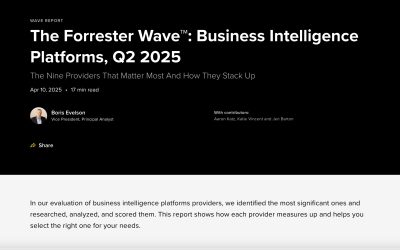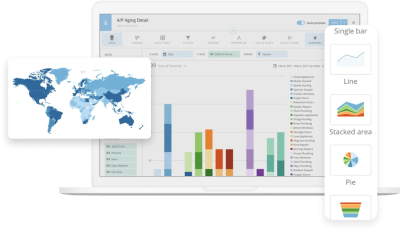How API-driven integration enhances collaboration with BI software
With API integration, you can easily connect your BI software to other business applications and data sources, making it easier to share data and collaborate with others.
There are many benefits to using API-driven integration for BI software, and learning to take advantage of this integration method can provide a major competitive advantage.
Let’s break down how API-driven integration works, what benefits it can offer, and how Domo’s API-driven integration can be used to add data collaboration capabilities to any open BI software.
What is an API?
API stands for an application programming interface. An API is a set of instructions that allow one piece of software to interact with another. When it comes to BI software, an API allows you to connect your BI software to other business applications and data sources.
For example, let’s say you want to use your BI software to analyze customer data from your CRM system. With an API-driven integration, you can easily connect your BI software to the CRM system and pull in the customer data you need.
How does API-driven integration work?
API-driven integration is a style of integration that relies on APIs to connect software applications. An API (application programming interface) is a set of rules that govern how one application can interact with another.
With an API, an application allows other developers to build tools and services that work with it. In the world of integration, an API acts as a contract between two applications. It defines how the two applications will communicate with each other and what data will be exchanged.
API-driven integration is a popular approach because it is flexible and scalable. It allows developers to decouple various parts of their systems and integrate them with third-party applications without understanding their underlying code or architecture.
Additionally, API-driven integration makes it easy to add new integrations or update existing ones without having to redeploy the entire system. Ultimately, this flexibility makes API-driven integration an attractive option for enterprises that are looking to build a robust, scalable integration strategy.
How API integration enables data collaboration
When it comes to data collaboration, API integration enables bi-directional data sharing between applications. This means that users can access data from other applications and push data back into those applications.
For example, let’s say you’re using a BI tool to analyze customer data. With API integration, you could easily pull in data from your CRM system, allowing you to get a complete view of your customers. But API integration doesn’t just stop there—you can also push data back into your CRM system. So, if you identify a high-value customer using your BI tool, you could quickly update your CRM records to reflect that.
This bi-directional data sharing enables true data collaboration, as users can now easily access and share data between different applications. And, because API integration is flexible and scalable, it’s easy to add new integrations or update existing ones—making it a perfect solution for companies that are looking to build a robust data collaboration strategy.

The benefits of API-driven integration
There are many benefits to using API-driven integration; learning to take advantage of this integration method can provide a major competitive advantage.
Some of the most notable benefits of API-driven integration include:
Flexibility: With API-driven integration, you can easily connect your BI software to other business applications and data sources. This makes it easy to add or update new integrations, giving you the flexibility to scale your integration strategy as your needs change.
Scalability: API-driven integration is a scalable solution that can grow with your business. As your company expands and your data needs become more complex, you can easily add new integrations or update existing ones without redeploying your entire system.
Improved data collaboration: API-driven integration enables bi-directional data sharing between applications, making it easy for users to access and share data between different applications. This improved data collaboration can give you a major competitive advantage by allowing you to make better, faster decisions.
Enhanced security: API-driven integration can help to improve security by allowing you to control access to your data. By defining strict rules around who can access which data, you can help to prevent unauthorized access and protect sensitive information.
Improved performance: API-driven integration can improve the performance of your BI software by making it easier to connect to multiple data sources. This can help to speed up data collection and analysis, giving you the insights you need to make better decisions.
Potential pitfalls of API-driven integration
API-driven integration is not without its challenges, however. One potential pitfall is that it can be difficult to manage many integrations. When you have many integrations, it can be hard to keep track of them all and to ensure that they are working properly.
Additionally, each integration has its own API, which means that you need to be familiar with the API in order to configure it properly. This can be a challenge, especially if you are not a developer. Fortunately, many of the resources available can help you learn about APIs and how to use them.
Any good BI tool will offer built-in API connectors to other popular pieces of business software, which allow businesses to connect to common tools through APIs without coding the solutions themselves.
Finally, API-driven integration can be complex and time-consuming to set up. It is important to carefully plan your integration strategy and to have a good understanding of your data before you begin. Otherwise, you may find yourself spending a lot of time configuring integrations and not getting the results you want.
Despite these challenges, API-driven integration is a powerful tool that can provide many benefits. When used correctly, it can give you a major competitive advantage by enabling bi-directional data sharing, improving data collaboration, enhancing security, and improving performance.

Examples of API integration at work
With the customization and bi-directional data sharing that API integration provides, it’s no wonder that more and more companies are turning to this approach to enable data collaboration.
Here are a few examples of how API integration can be used to add data collaboration capabilities to any open BI software:
1. Connecting BI software to other business applications can make it easier to share data and collaborate with others.
For example, you could connect your BI software to your CRM system to get customer insights, or connect it to your marketing automation system to get marketing campaign data. This would allow you to easily share data between different departments and ensure that everyone is working with the most up-to-date information.
2. API integration can also be used to connect BI software to external data sources.
This would give you access to a wider range of data, which could be helpful if you are looking to make better business decisions. For example, you could connect your BI software to social media data sources to get insights into what people are saying about your brand. Or, you could connect it to financial data sources to get real-time stock information.
3. You can also use API integration to create custom data mashups that can be used in your BI reports and dashboards.
For example, you could combine sales data with customer satisfaction ratings to better understand how your company’s products are performing. When you have access to this type of data, you can make better decisions about what products to sell and how to market them.
4. API integration can be used for advanced data analysis and reporting.
For example, you could use API integration to connect your BI software to a machine learning platform so you can do predictive modeling on your company’s data. Once you have the results of the predictive modeling, you can then use them to make better business decisions.
5. API integration can also be used to improve the security of your BI software.
API integrations allow for more control over data access and governance. By pulling data in an automatic, programmatic way, businesses can remove many of the risk factors of pulling data manually and control access to it in a much neater way.
Business intelligence and API-driven integration
If you are ready to utilize the power of API-driven integration, a BI tool can help. Most market-leading BI platforms include a robust set of API connectors that make connecting to any data source easy.
When you connect to data sources through your BI tool’s APIs, you can easily create custom data mashups, perform advanced data analysis, and build robust reporting dashboards. Plus, with API-driven integration within a BI tool, you can easily manage all of your integrations in one place—making it easy to keep track of them and ensure that they are working properly.
It’s no wonder why API-driven integration is becoming the preferred method for data collaboration. If you are looking for a way to add data collaboration capabilities to your business software, a BI-driven API system can help.
Check out some related resources:

Domo Named a Strong Performer in The Forrester Wave™️: Business Intelligence Platforms, Q2 2025

8 Best AI Tools for Data Visualization






